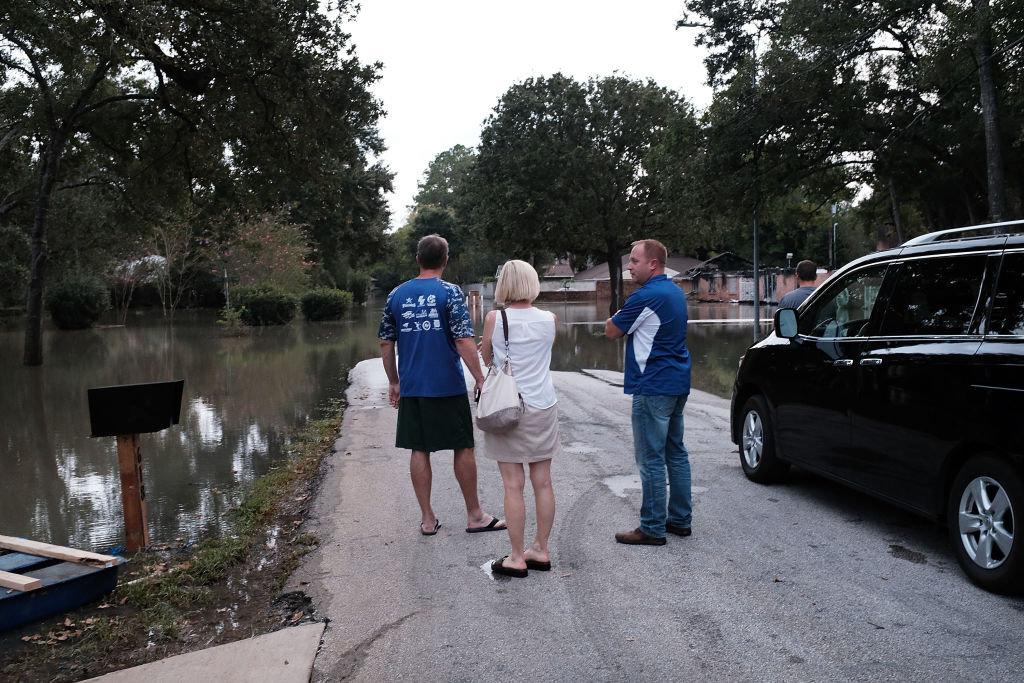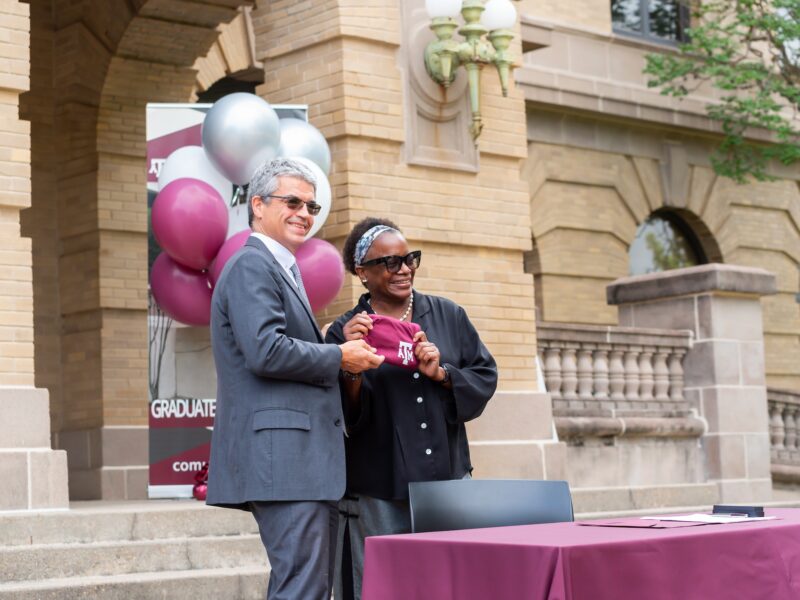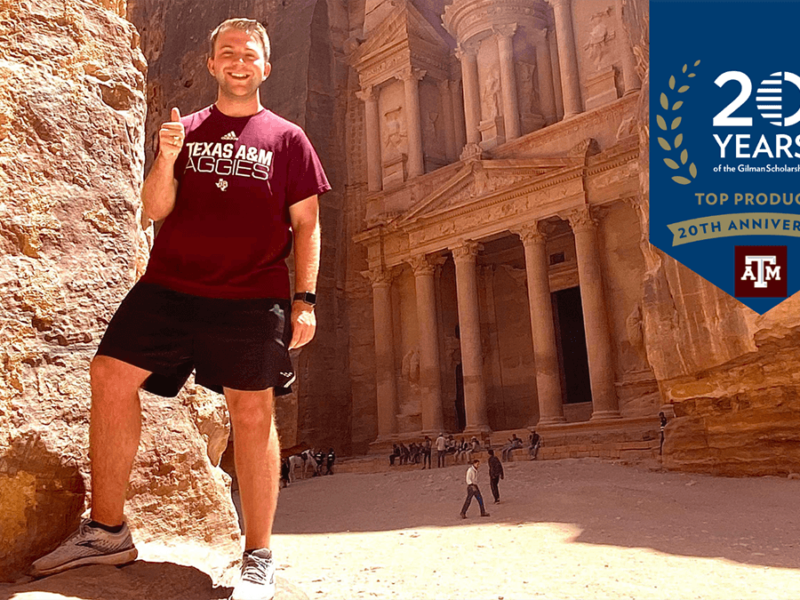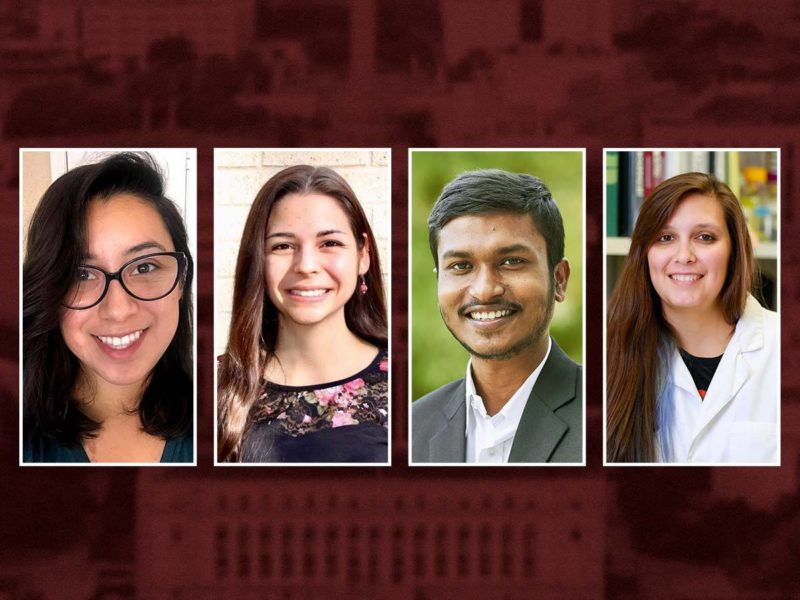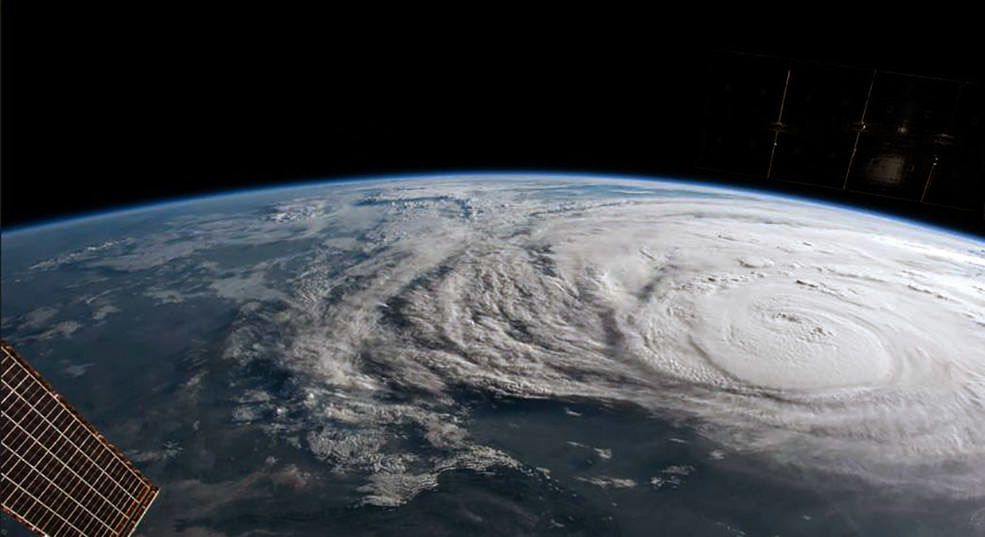
By Texas A&M University Division of Marketing & Communications staff
The 2018 hurricane season begins June 1 and Texas A&M University has nearly 40 faculty experts available to discuss every aspect of hurricanes from early formation, recovery and resilience and more until the season ends Nov. 30.
In this guide, media will find important information for not only experts, but research institutes, helpful web based tools, databases and a central point of contact for Texas A&M University inquiries regarding hurricane preparedness and response.
An interactive PDF version of this guide is available for download.
Important Online Resources And Contacts
- Texas Task Force One: An elite, highly trained and highly specialized group trained in disasters and terrorism. It can be mobilized within hours and is equipped to remain on 24-hour duty for days at a time. Contact Jeff Saunders (979) 458-6800 or saunders@teexmail.tamu.edu.
- The Texas Coastal Planning Atlas: Detailed geographic information that assists in providing guidance in decision-making, policy, and planning for Texans living in this 18-county coastal region.
- Buyers B-Where: Enter a street address and receive a graphic and statistical risk assessment for a specific property. Comprehensive, easy to understand information delivered on-the-fly will provide a critical resource for existing and future property owners interested in making sound and safe investment decisions.
- Texas Extension Disaster Education Network (EDEN): The Hurricane Resources website is available to the public. The site has links to information about both pre- and post-storm needs. Topics include general safety, food, people with special needs, health issues, restoring the home, financial recovery, and care for trees, pets and other animals, and septic systems. Contact Andy Vestal, (979) 862-3013, t-vestal@tamu.edu and Joyce Cavanagh, (979) 845-3850, jacavanagh@tamu.edu.
- Hazard Reduction & Recovery Center: Established at Texas A&M University in 1988, the HRRC is an interdisciplinary collaborative effort focused on hazard analysis, emergency preparedness and response, disaster recovery, and hazard mitigation. Researchers study the full range of natural disasters and technological hazards.
- Texas Community Watershed Partners Program (TCWP): The TCWP provides education and outreach to local governments and citizens on the impacts of land use on watershed health and water quality.
- Texas A&M University Division of Marketing & Communications News and Information: tamunews@tamu.edu.
- The Texas Sea Grant College Program’s Hurricane Preparedness website and Post-Hurricane Harvey Recovery Resources website are available to the public with links to information specific to Texas and relevant to future storms. Free publications to help Texans prepare are available as downloadable PDFs.
How Hurricanes Form
- John Nielsen-Gammon: Regents Professor of atmospheric sciences in the Texas A&M University College of Geosciences
- Nielsen-Gammon serves as Texas State Climatologist and is an expert on severe storms, how hurricanes form, the history of Texas hurricanes, rapid formation of hurricanes in the Gulf of Mexico and the history of severe storms and hurricanes in the past 100 years.
- Contact: (979) 862-2248, n-g@tamu.edu
- Robert Korty: Professor of atmospheric sciences in the Texas A&M University College of Geosciences
- Korty is an expert on how hurricanes affect oceans and how climate affects hurricanes.
- Contact: (979) 847-9090, korty@tamu.edu
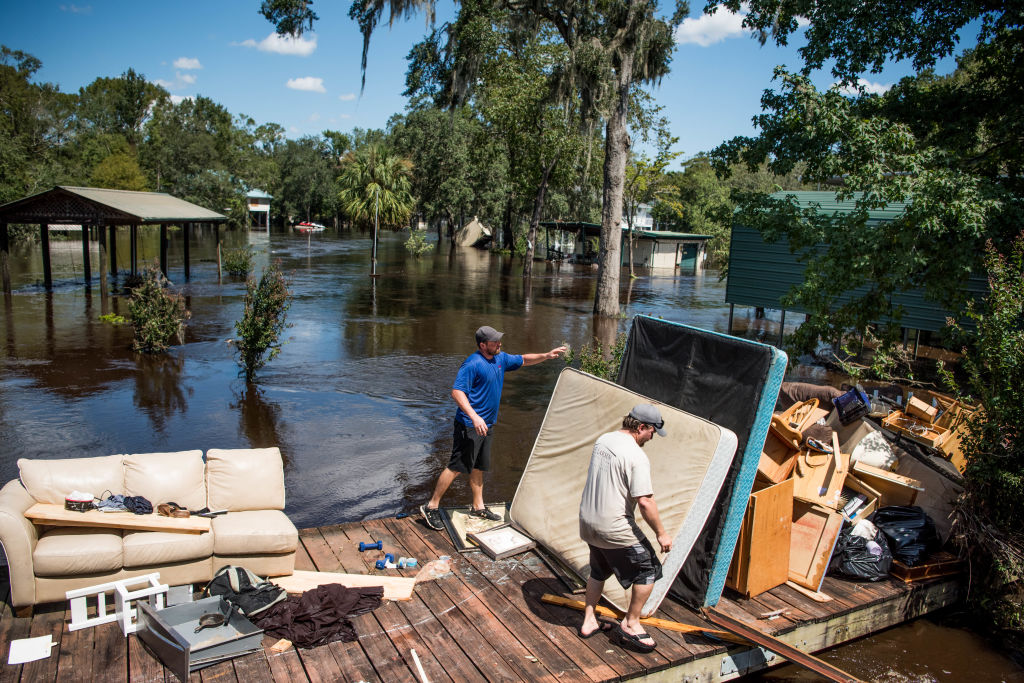
Marc St. Peter, left, and Chris Wisor lend a hand cleaning up as floodwaters from Hurricane Irma recede September 13, 2017 in Middleburg, Florida. (Photo by Sean Rayford/Getty Images)
Structural And Water Damage To Offshore Structures
- Jean Louis Briaud: Professor of civil engineering in the Texas A&M University College of Engineering
- Briaud is an expert in erosion and “scour,” the remains of buildings damaged by seawater. He also is proficient in how water sweeps away materials or bridges and soil compaction in levees.
- Contact: (979) 845-3795, briaud@tamu.edu
- Robin Autenrieth: Interim head of the Zachry Department of Civil Engineering, Texas A&M University
- Autenrieth is an expert in water cleanup, environmental damage of waters from hurricanes and floods, and contaminated water and the many problems it poses.
- Contact: (979) 845-3593, rautenrieth@civil.tamu.edu
- Rick Mercier: Professor of engineering and director of the Offshore Technology Research Center
- Mercier is an expert in off-shore drilling platforms, hurricane damage to oil rigs or any deep water off-shore structure, and oil rigs cut off from production.
- Contact: (979) 845-6000, rsmercier@tamu.edu
- John Jacob: Professor and director of the Texas Coastal Watershed Program
- Jacob is an expert on resilient coastal communities — or how coastal communities can rebound from coastal hazards like hurricanes.
- Contact: (832) 671-8171, jjacob@tamu.edu.
- Heather Wade: Senior associate director of the Texas Sea Grant Program and co-director of the Community Resilience Collaborative
- Based in College Station, is an expert in environmental hazards management, hazard mitigation, post-disaster redevelopment planning, and evaluating how well communities are prepared for and can recover from hurricanes. She co-leads the CRC, a research-and-extension-based planning program to increase the resilience of the state’s coastal communities to natural hazards and to enhance or restore their habitats and ecosystems.
- Contact: (361) 205-7503, hbwade@tamu.edu
- Gary Jeffress: Director of the Conrad Blucher Institute for Surveying and Science at Texas A&M University-Corpus Christi
- Jeffress is an expert in storm damage on the Texas coast, the decline of surface areas on the coast line in the last 50 years and how forces combine to make certain areas of the coast more vulnerable than others.
- Contact: (361) 825-2720, jeffress@tamucc.edu
- Brent McRoberts: Research assistant professor of geography in the Texas A&M University College of Geosciences
- McRoberts is an expert in power outage prediction modeling, which gives forecasts of how many utility customers will lose power during and after a hurricane.
- Contact: (979) 845-6075, mcrobert@tamu.edu
Environmental And Ecosystem Effects Of Hurricanes
- Shari Yvon-Lewis: Department head and professor for the Department of Chemical Oceanography in the Texas A&M University College of Geosciences
- Yvon-Lewis and is a chemical oceanography and biogeochemistry expert who has conducted extensive post-hurricane research in Galveston Bay and has a thorough dataset of Bay water quality data before and after the hurricane.
- Contact: (979) 458-1816, syvon-lewis@ocean.tamu.edu
- Anthony Knap: Director of the Geochemical and Environmental Research Group (GERG) and professor of oceanography in the Texas A&M University College of Geosciences
- Knap is an expert in effects of contaminants on marine environments, ocean health and human health interactions. He also co-leads the Texas A&M Superfund.
- Contact: (979) 458-9328, tknap@tamu.edu.
- Lisa Campbell: Professor of oceanography in the Texas A&M University College of Geosciences
- Campbell is an expert in biological oceanography, phytoplankton ecology, harmful algal blooms and is well-versed in the effects hurricanes can have on ecosystems.
- Contact: (979) 845-5706, lisacampbell@tamu.edu
- Jason Sylvan: Oceanography assistant professor in the Texas A&M University College of Geosciences
- Sylvan is well-versed in the short-term and long-term effects of hurricanes on environments and ecosystems, including coral reefs. Kathryn Shamberger, oceanography assistant professor, and Steve DiMarco, oceanography professor, are also available to comment.
- Contact:(979) 845-5105 or jasonsylvan@tamu.edu
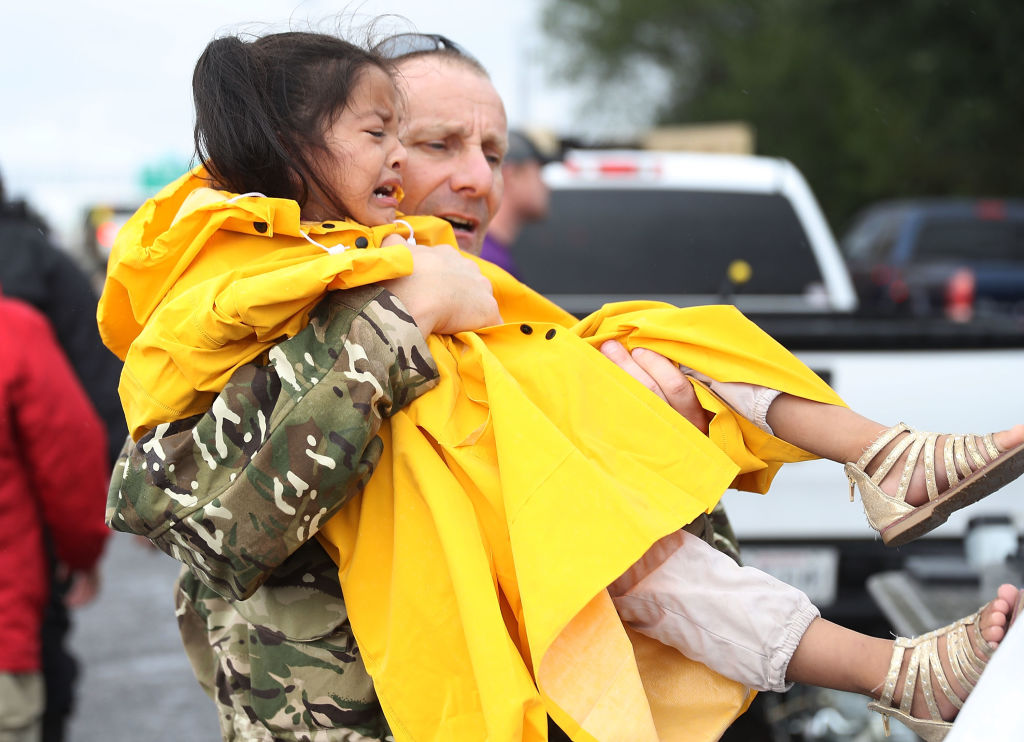
Evacuees wait to be transported to a shelter after being rescued from the flooding of Hurricane Harvey on August 30, 2017 in Port Arthur, Texas. Harvey, which made landfall north of Corpus Christi late Friday evening, is expected to dump upwards to 40 inches of rain in Texas over the next couple of days. (Photo by Joe Raedle/Getty Images)
Hurricane Effects On People And Pets
- Wesley Bissett: Professor of Veterinary Medicine in the Texas A&M University College of Veterinary Medicine & Biomedical Sciences
- Bissett is an expert on displaced pets, pets relocating to unfamiliar areas, pets facing isolation and separation anxiety, etc.
- Contact: (979) 845-2351, wbissett@cvm.tamu.edu
- Deb Zoran: Professor of Veterinary Medicine in the Texas A&M University College of Veterinary Medicine & Biomedical Sciences
- Zoran is an expert on displaced pets, pets relocating to unfamiliar areas, pets facing isolation and separation anxiety, etc.
- Contact: (979) 845-2351, dzoran@cvm.tamu.edu
- Bill Moyer: Professor and head of large animal clinical services in the Texas A&M University College of Veterinary Medicine & Biomedical Sciences
- Moyer was put in charge of converting Texas A&M’s Large Animal Hospital into special human needs hospital that served hundreds of elderly and special needs patients during Hurricane Rita and will take a similar leadership role if such plans are needed again.
- Contact: (979) 845-9127, wmoyer@cvm.tamu.edu
- Garry Adams: Professor of veterinary medicine in the Texas A&M University College of Veterinary Medicine & Biomedical Sciences
- Adams is well-versed on numerous public health issues, diseases stemming from disasters and treatment strategies for dealing with large numbers of injured or sick animals.
- Contact: (979) 845-5092, gadams@cvm.tamu.edu
- Murl Bailey: Professor of veterinary medicine in the Texas A&M University College of Veterinary Medicine & Biomedical Sciences
- Bailey is an expert on zoonotic diseases (those passed from animals to humans) and problems that can arise if this occurs.
- (979) 845-7261, m-bailey@tamu.edu
- Angela Clendenin: instructional assistant professor in the Texas A&M University School of Public Health
- Clendenin has served as the public information offer for the Veterinary Emergency Team and has expertise in risk communication and emergency management.
- Contact: Holly Shive, (979) 436-0613, hshive@tamhsc.edu
- Natalie Johnson, assistant professor in the Texas A&M University School of Public Health
- Johnson studies the effects of air pollution on pregnant women and their babies, and she has looked at the effects post-hurricane emissions of potentially dangerous chemicals may have on this population.
- Contact: Holly Shive, (979) 436-0613, hshive@tamhsc.edu
- Jennifer Horney: Epidemiology & Biostatistics department head in the Texas A&M University School of Public Health
- Horney is an expert on public health preparedness and resilience after disasters.
- Contact: Holly Shive, (979) 436-0613, hshive@tamhsc.edu
- Tiffany Radcliff: Associate professor and associate department head of the Health Policy and Management department in the Texas A&M University School of Public Health
- Radcliff researches how disasters affect medical care delivery and how the medical practices recover after such events.
- Contact: Holly Shive, (979) 436-0613, hshive@tamhsc.edu
Societal And Social Aspects Of Hurricanes
- Stjepan Mestrovic: Professor of sociology in the Texas A&M University College of Liberal Arts
- Mestrovic serves as an expert in social order (or lack of it) and lawlessness in times of crises.
- Contact: (979) 845-6121 or mestrovic@tamu.edu
- Stephen Maren: Claude H. Everett, Jr. ’47 Chair of Liberal Arts in the Department of Psychological and Brain Sciences in the Texas A&M University College of Liberal Arts
- Maren’s research includes neural systems for emotion, learning, and memory as well as contextual regulation of memory encoding and retrieval, and fear, anxiety, and PTSD.
- Contact: 979-458-7960, maren@tamu.edu
Beach Erosion
- William Merrell: Professor and George P. Mitchell ’40 chair in marine sciences at the Texas A&M University Galveston Campus
- Merrell serves on the City of Galveston Hurricane Task Force. He is also an expert on beach and shoreline erosion, effects of hurricanes on the entire shoreline of the Gulf of Mexico and proponent of the “Ike Dike,” a coastal surge suppression barrier for the Houston/Galveston area, based on a similar project in the Netherlands.
- Contact: (409) 740-4732, merrellw@tamug.edu
Chemical Safety
- Sam Mannan: Director of the TEES Mary K O’Connor Process Safety Center and professor of chemical engineering
- Mannan is a leading expert on hazardous chemical safety and storage and risk assessment.
- Contact: (979) 862-3985, mannan@tamu.edu
Coastal Infrastructure And Ecosystems
- Samuel Brody: Professor of marine sciences and urban planning and the George P. Mitchell Chair in Sustainable Coasts at the Texas A&M University Galveston Campus
- Brody directs the Institute for Sustainable Coastal Communities (ISCC) and the Center for Texas Beaches and Shores (CTBS), headquartered at Texas A&M at Galveston. Brody helps conserve and protect the Texas shoreline, bays and waterways. He prepares coastal communities to absorb, adapt and respond to hurricanes, coastal storms and flooding.
- Contact: (409) 741-4076, sbrody@tamu.edu
- Ignacio Rodriguez-Iturbe: Distinguished University Professor and Texas A&M Engineering Experiment Station Distinguished Research Professor in the Department of Ocean Engineering
- Rodriguez-Iturbe studies coastal ecosystems and the challenges they pose to coastal cities and communities.
- 979-845-3141, irodriguez@ocen.tamu.edu

A road sign warns travelers of the the approaching Hurricane Harvey on August 25, 2017 in Corpus Christi, Texas. Hurricane Harvey has intensified into a hurricane and is aiming for the Texas coast with the potential for up to 3 feet of rain and 125 mph winds. (Joe Raedle/Getty Images)
Warning Systems, Evacuation, Hazard Mitigation, Sustainable Development And Community Recovery
- Sherry Bame: Professor in the Department of Landscape Architecture and Urban Planning and a Hazard Reduction and Recovery Center (HRRC) fellow.
- Bame has a special interest in health systems planning and policy, environmental health, and health-related disaster planning, particularly related to 211 call centers and unmet needs.
- Contact: (979) 845-8406, sbame@tamu.edu
- Eric Bardenhagen: Professor in the Department of Landscape Architecture and Urban Planning and a Hazard Reduction and Recovery Center (HRRC) fellow.
- Bardenhagen’s interests include natural and cultural resource planning, natural hazards and disaster planning for national parks.
- (979) 458-3414, bardenhagen@tamu.edu
- John Cooper: Associate Professor of Practice, Department of Landscape Architecture and Urban Planning and Outreach Coordinator at the HRRC and the Center for Housing and Urban Development.
- Cooper’s areas of interest include principles of inclusive planning and plan quality. His research and outreach focuses on emergency management, disaster planning and mitigation with a primary focus on socially vulnerable populations and communities.
- (979) 862-2272, jcooper@arch.tamu.edu
- Walter Gillis Peacock: Director of the HRRC and professor of urban planning.
- His research has focused on evacuation, restoration and long-term recovery from disasters, disaster mitigation and resilience.
- (979) 845-7853, peacock@tamu.edu
- George O. Rogers: Senior fellow at the HRRC, director of the Urban and Regional Science Graduate program and professor of landscape architecture and urban planning.
- His research has focused on warning systems, risk perception and sustainable development.
- (979) 845-7284 or grogers@tamu.edu
- Shannon Van Zandt: Director of the Master of Urban Planning program , associate professor in the Department of Landscape Architecture and Urban Planning, director of the Center for Housing and Urban Development, and HRRC fellow, and the director of the Master of Urban Planning program.
- Van Zandt’s areas of interest include post-disaster housing recovery, social vulnerability, community resilience and hazards mitigation.
- (979) 458-1233, svanzandt@tamu.edu
Hurricanes, Marine Life And Seafood
- Andrew Ropicki: Assistant professor and Texas Sea Grant marine economics extension specialist.
- He can comment on assessments of storm impacts on fishing infrastructure (vessels, docks, processing equipment, etc.) and on sessile fisheries (oysters).
- 361-825-6210, ropicki@ag.tamu.edu
###
More news about Texas A&M University
Follow us on Twitter
